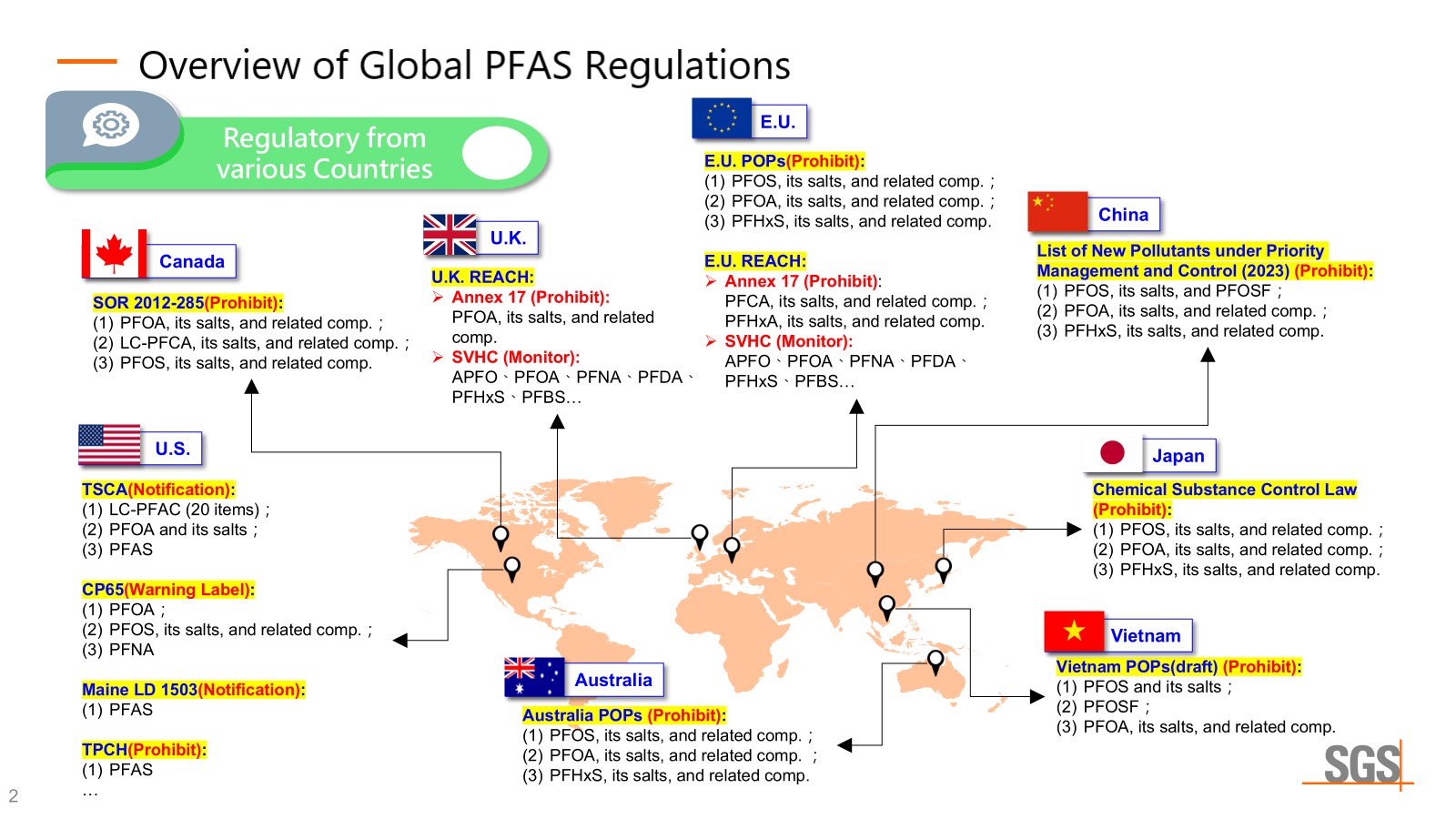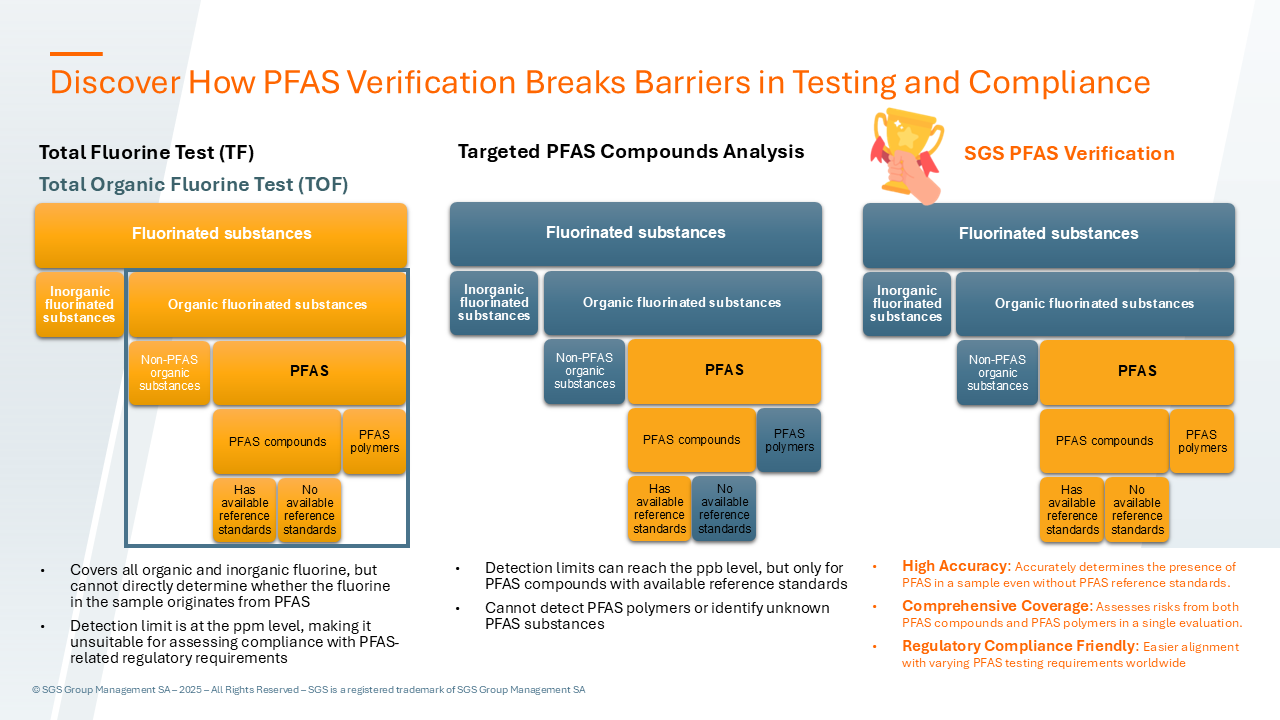SGS PFAS Verification Service|Comprehensive Risk Detection for Compounds and Polymers

Service Outline (click to jump to section)
Service Details (click to start reading) 👆
- PFAS Verification Service
- Why Care About PFAS
- Global PFAS Regulatory Trends
- PFAS 101: Key Chemical Knowledge You Need
- Why PFAS is So Hard to Detect
- SGS PFAS Verification: Three Breakthroughs
- Why Did We Develop This Technology?
- Conclusion
Service Details – Full Content
1. SGS PFAS Verification Service
a. Service Overview:
SGS’s PFAS Verification service breaks through the limitations of traditional testing by detecting the presence of PFAS without relying on reference standards. This service is specifically designed to help manufacturers, brands, and supply chains quickly respond to regulatory requirements across different regions worldwide. It answers the critical question:
“Does my product contain any PFAS compounds or polymers?”
and provides the scientific evidence you need to overcome testing barriers in multiple markets.
b. Key Features
-
- Comprehensive detection covering both PFAS compounds and PFAS polymers
- Applicable to product development, supply chain management, and compliance assessments
- Eliminates blind spots of conventional testing, providing more complete risk insights
c. Why Choose SGS
-
- Global Leadership: SGS is the world’s leading company in inspection, verification, testing, and certification
- Expert Team: Developed and validated by SGS C&P’s Chemical Analysis and Sustainability Services team in Taiwan
- Regulatory Foresight: Closely tracks the latest PFAS developments in the EU, U.S., and Asian markets
- Worldwide Network: Leverages SGS’s global resources to help you respond quickly to diverse market requirements
2. Why Care About PFAS
PFAS (Per- and Polyfluoroalkyl Substances) are globally recognized as "forever chemicals" of high concern. Their defining characteristic is the extremely stable carbon-fluorine (C–F) bond, which makes them almost non-degradable in the environment. As a result, PFAS persist and accumulate, causing long-term impacts on both the environment and human health.
Whether it’s the European Union’s stringent concentration limits or the United States’ mandatory reporting requirements for any detected PFAS, manufacturers are being challenged with the question: “Do you truly understand the composition of your products?”
a. What is PFAS
In 2021, the OECD (Organisation for Economic Co-operation and Development) introduced a widely recognized definition of PFAS (Per- and Polyfluoroalkyl Substances), which has since been adopted by many government regulators worldwide.
PFAS are defined as chemical substances that contain at least one fully fluorinated methyl group (–CF₃) or methylene group (–CF₂–), with no hydrogen, chlorine, bromine, or iodine atoms attached (with limited exceptions).
The OECD, headquartered in Paris, France, is an intergovernmental organization of 37 member countries, and its definition provides the foundation for global PFAS regulatory frameworks.
b. Why the World is Paying Attention to PFAS
-
- Persistent "Forever Chemicals":
PFAS are often referred to as “forever chemicals” due to their extreme persistence in the environment. Their chemical structure, mainly composed of carbon and fluorine atoms, forms strong carbon–fluorine (C–F) bonds. These bonds give PFAS unique properties such as non-stick, water-repellent, oil-resistant, low-friction, and long-lasting stability. Because of this durability, PFAS do not easily break down in nature and are classified as persistent chemicals.
-
- Mobility and Bioaccumulation:
The chemical stability of PFAS prevents natural degradation, allowing these substances to migrate through soil, water, and air while continuously accumulating in the environment and in living organisms. Over time, PFAS build up in ecosystems and enter the food chain, raising global concerns about long-term exposure.
-
- Health Risks:
Recent scientific studies have shown that the bioaccumulation of PFAS in humans and animals can cause serious health issues. Documented risks include liver damage, certain types of cancer, pregnancy complications, developmental effects, and birth defects. PFAS can also be transferred from mother to child through the placenta and breastfeeding, posing additional risks to infants.
-
- Widespread Applications:
PFAS are widely used across industries and in daily life due to their unique stability and water- and oil-resistant properties. They are applied as solvents, coatings, surfactants, and cleaning agents, and are also used as processing aids in the production of fluoropolymers and rubber. As a result, PFAS are commonly found in textiles, food packaging, lubricants, refrigerants, electronic products, building materials, and many consumer goods, highlighting their broad applications but also their widespread environmental impact.
c. Common PFAS Applications in Electronics & Electricals:
Per- and polyfluoroalkyl substances (PFAS) are widely used due to their water-resistant, oil-repellent, and heat-resistant properties. These characteristics make PFAS essential in both consumer goods and industrial applications. For example:
-
- Non-stick cookware coatings provide convenience in cooking.
- Textiles and outdoor gear retain water-repellent and stain-resistant performance.
- Food utensils and kitchenware resist high temperatures and prevent sticking.
- Food packaging materials protect against oil and grease penetration.
These examples highlight the versatility and multifunctionality of PFAS in modern life. From stain-resistant household coatings and food packaging to industrial paints, lubricants, and sealing materials, PFAS applications are diverse and deeply embedded in everyday products.PFAS also play a critical role in the electronics and electrical industries, where performance, durability, and precision are crucial. Common applications include:
-
- Metal Plating:
Used as wetting agents and mist suppressants to reduce the surface tension of plating solutions and minimize aerosol emissions.
-
- Metal Processing:
Applied to reduce surface tension, improve the flow of metal coatings, suppress acid mist, prevent steel corrosion, and extend the service life of plating baths.
-
- Consumer Mixtures:
Found in cleaning agents for glass, metal, and ceramics, as well as rain-repellent liquids used in the aviation industry.
-
- Medical Devices:
Applied in medical textiles, implants, fluororubber components, medical tubing and catheters, packaging, and electronic medical equipment.
-
- Electronics & Semiconductors:
Extensively used in wires and cables, printed circuit boards (PCBs), flat panel displays, capacitors, LCDs, semiconductor photoresists, silicon wafers, cooling liquids, and cleaning agents.
d. PFAS Exposure Pathways
Per- and polyfluoroalkyl substances (PFAS) are synthetic, man-made chemicals that do not occur naturally in the environment. They are produced in chemical plants and supplied to various industries for use in diverse manufacturing processes. PFAS are not only applied during industrial production, but are also incorporated into many end-use consumer products.
During manufacturing, product use, and waste disposal, PFAS can be released into the air, soil, and water. Because of their extreme chemical stability, PFAS do not break down in soil and can migrate through groundwater, spreading across the environment. These properties give PFAS a high potential for mobility, toxicity, and bioaccumulation—similar to how heavy metals can accumulate in living organisms over time.
3. Global PFAS Regulatory Trends
| EU | UK | US |
POPs (Prohibit):
REACH
|
REACH
|
TSCA (Notification):
CP65 (Warning Label):
Maine LD 1503 (Notification):
TPCH (Prohibit):
... |
| CANADA | CHINA | JAPAN |
SOR 2012-285 (Prohibit):
|
List of New Pollutants under priority management and control (2023) (Prohibit):
|
CSCL (Prohibit):
|
| VIETNAM | AUSTRALIA | |
|
Vietnam POPs (Draft) (Prohibit):
|
Australia POPs (Ban effective July 1, 2025) (Prohibit):
|

4. PFAS 101: Key Chemical Knowledge You Need
From a chemical perspective, fluorine-containing substances fall into two major categories:
- Inorganic Fluorine
- Examples: Calcium fluoride (CaF₂), Sodium fluoride (NaF)
- Commonly found in industrial raw materials and additives
- Organic Fluorine
- Organic compounds containing carbon-fluorine bonds, including:
- PFAS Compounds: such as PFOA and PFOS; small molecules with high mobility
- PFAS Polymers: such as PTFE (Teflon); high molecular weight, used in non-stick cookware, sealing materials, etc
- PFAS Mixtures: Perfluoro compounds, C5-18
- Non-PFAS Organic Fluorine: such as CFCI₃; used in refrigerants, foaming agents, etc
- Organic compounds containing carbon-fluorine bonds, including:
5. Why PFAS is So Hard to Detect
a. Current Testing Methods & Limitations
-
- Total Fluorine (TF)
-
- Covers all organic and inorganic fluorine, but cannot directly determine whether the fluorine in the sample originates from PFAS
- Detection limit is at the ppm level, making it unsuitable for assessing compliance with PFAS-related regulatory requirements
-
- Total Organic Fluorine (TOF)
- Focuses on organic fluorine, yet still cannot directly determine whether the fluorine in the sample comes from PFAS
- Detection limit is at the ppm level, making it unsuitable for assessing compliance with PFAS-related regulatory requirements
- Targeted PFAS Compounds Analysis
- Detection limits can reach the ppb level, but only for PFAS compounds with available reference standards
- Cannot detect PFAS polymers or identify unknown PFAS substances
- Total Fluorine (TF)
b. Why These Tests Are Not Enough for Regulations
This explains why many past total fluorine reports showed high fluorine content but failed to confirm if restricted PFAS were truly present—this is the blind spot in PFAS detection.
6. SGS PFAS Verification: Three Breakthroughs
- High Accuracy: Accurately determines the presence of PFAS in a sample even without PFAS reference standards
- Comprehensive Coverage: Assesses risks from both PFAS compounds and PFAS polymers in a single evaluation
- Regulation-Friendly: Easier alignment with varying PFAS testing requirements worldwide

7. Why Did We Develop This Technology?
a. Global PFAS Regulatory Trends & Gaps
PFAS regulations are tightening worldwide, but definitions and requirements vary by country, posing challenges for multinational companies. For example:
-
- EU PFAS Regulations
- PFAS compounds with standards (acids and salts): concentration limit at 25 ppb
- PFAS-related substances with standards: sum concentration limits apply
- PFAS polymers: if total fluorine (TF) > 50 ppm, companies must prove the fluorine source is not PFAS
- US PFAS Regulations
- Based on TSCA (Toxic Substances Control Act) framework
- Any detected PFAS, regardless of concentration, must be reported
- EU PFAS Regulations
b. Compliance Challenges for Companies
-
- Different detection thresholds across regions make a single test method insufficient
- Businesses need a new solution capable of detecting both PFAS compounds and polymers simultaneously
8. Conclusion:
With SGS PFAS Verification, companies gain more than just a testing service – they gain confidence in global compliance. Our solution answers the key question:
“Does my product contain any PFAS compounds or polymers?”
It provides scientific evidence to navigate regulatory requirements across different markets, helping you act quickly and confidently.

